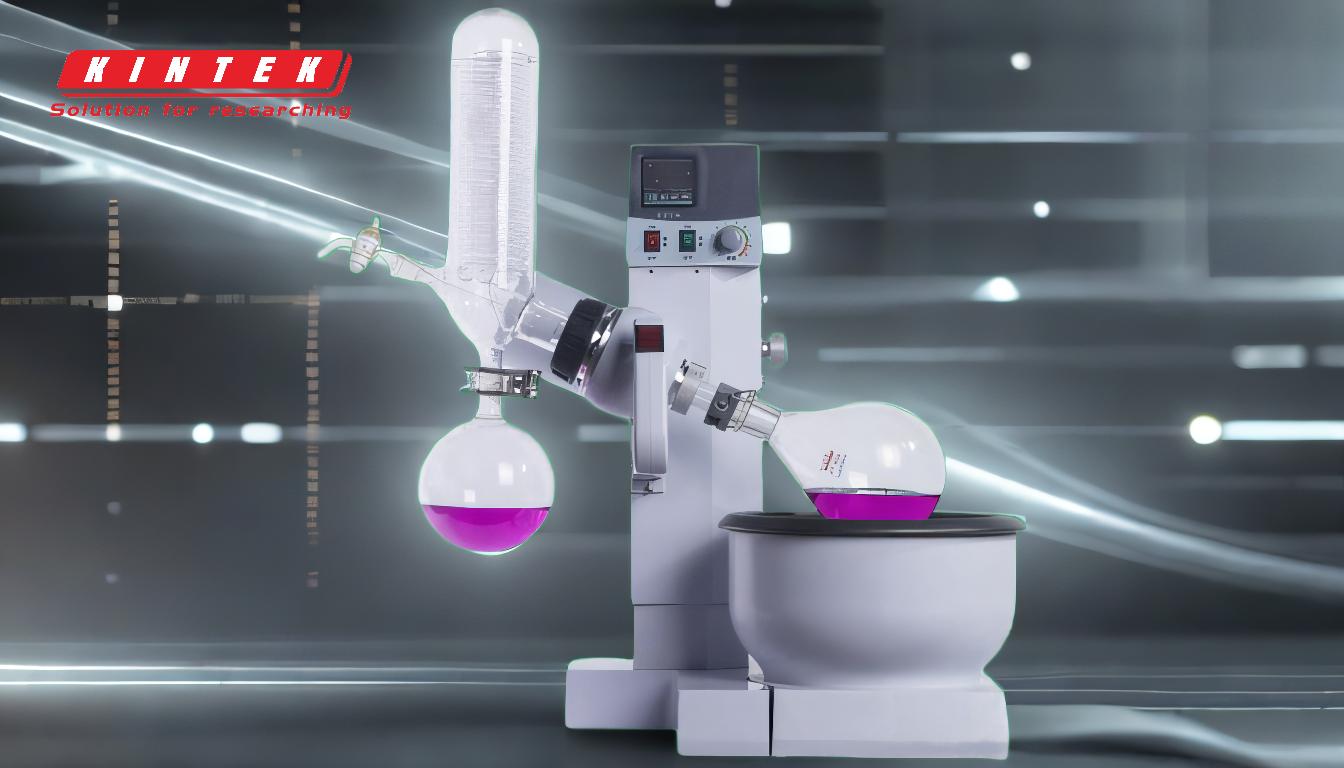A rotary evaporator is a sophisticated piece of laboratory equipment designed for efficient solvent removal and sample concentration. Its construction involves a combination of materials and components that ensure durability, chemical resistance, and functionality. The primary materials used include stainless steel, aluminum alloy, borosilicate glass, and PTFE (polytetrafluoroethylene). These materials are chosen for their strength, resistance to corrosion, and ability to withstand harsh chemicals. The key components of a rotary evaporator include the heat bath, rotor, condenser, solvent trap, evaporation flask, receiving flask, and motor. Together, these materials and components enable the device to operate effectively under vacuum conditions, ensuring precise and safe evaporation processes.
Key Points Explained:

-
Primary Materials Used in Rotary Evaporators:
- Stainless Steel and Aluminum Alloy: These materials are extensively used in the main structure of the rotary evaporator. Stainless steel provides strength and resistance to corrosion, while aluminum alloy contributes to the device's lightweight and aesthetic appeal. Together, they ensure the equipment is both durable and visually appealing.
- Borosilicate Glass: This type of glass is used for components like the evaporation flask, condenser, and receiving flask. Borosilicate glass is highly resistant to thermal shock and chemical corrosion, making it ideal for handling a wide range of solvents and temperatures.
- PTFE (Polytetrafluoroethylene): PTFE is used in seals and joints due to its exceptional chemical resistance and non-reactive properties. It ensures that the rotary evaporator can handle harsh chemicals without degradation or contamination.
-
Key Components of a Rotary Evaporator:
- Heat Bath: This component is typically made of stainless steel and contains a heating element to provide controlled heat to the evaporation flask. It ensures uniform heating of the sample, facilitating efficient evaporation.
- Rotor: The rotor, often constructed from stainless steel or aluminum alloy, rotates the evaporation flask. This rotation increases the surface area of the solvent, accelerating the evaporation process.
- Condenser: The condenser, usually made of borosilicate glass, cools the vaporized solvent, converting it back into liquid form. It is often designed as a serpentine or coil structure to maximize cooling efficiency.
- Solvent Trap: This component collects the condensed solvent. It is typically made of borosilicate glass or PTFE to ensure chemical compatibility and ease of cleaning.
- Evaporation Flask: The evaporation flask, usually a round-bottom or eggplant flask, holds the sample to be concentrated. It is made of borosilicate glass to withstand high temperatures and chemical exposure.
- Receiving Flask: This flask collects the concentrated sample after evaporation. Like the evaporation flask, it is made of borosilicate glass.
- Motor: The motor, often housed in a stainless steel or aluminum alloy casing, drives the rotation of the evaporation flask. It is designed for precise speed control to optimize the evaporation process.
-
Additional Accessories and Their Materials:
- Vacuum Pump: While not part of the main structure, the vacuum pump is essential for creating the low-pressure environment needed for evaporation. It is typically made of materials like stainless steel and PTFE to ensure durability and chemical resistance.
- Bump Trap: This component, often made of borosilicate glass, prevents the sample from splashing into the condenser during rapid boiling. It ensures the integrity of the evaporation process.
- 3-Way Piston: Made of materials like PTFE or stainless steel, the 3-way piston controls the pressure and solvent transfer within the system. It is crucial for maintaining precise vacuum conditions.
-
Functional Integration of Materials and Components:
- The combination of stainless steel, aluminum alloy, borosilicate glass, and PTFE ensures that the rotary evaporator is both robust and chemically resistant. This integration allows the device to handle a wide range of solvents and temperatures, making it versatile for various laboratory applications.
- The design of each component, from the heat bath to the condenser, is optimized for efficient heat transfer, solvent recovery, and sample concentration. The use of high-quality materials ensures long-term reliability and minimal maintenance.
In summary, the materials and components of a rotary evaporator are carefully selected to ensure durability, chemical resistance, and efficient operation. The combination of stainless steel, aluminum alloy, borosilicate glass, and PTFE, along with the precise design of key components, makes the rotary evaporator an indispensable tool in modern laboratories.
Summary Table:
| Component | Material | Function |
|---|---|---|
| Heat Bath | Stainless Steel | Provides controlled heat for uniform sample evaporation. |
| Rotor | Stainless Steel/Aluminum | Rotates the evaporation flask to increase solvent surface area. |
| Condenser | Borosilicate Glass | Cools vaporized solvent, converting it back to liquid. |
| Solvent Trap | Borosilicate Glass/PTFE | Collects condensed solvent for easy recovery. |
| Evaporation Flask | Borosilicate Glass | Holds the sample for concentration; resistant to high temperatures. |
| Receiving Flask | Borosilicate Glass | Collects the concentrated sample after evaporation. |
| Motor | Stainless Steel/Aluminum | Drives the rotation of the evaporation flask with precise speed control. |
| Vacuum Pump | Stainless Steel/PTFE | Creates low-pressure conditions for efficient evaporation. |
| Bump Trap | Borosilicate Glass | Prevents sample splashing during rapid boiling. |
| 3-Way Piston | PTFE/Stainless Steel | Controls pressure and solvent transfer for precise vacuum conditions. |
Upgrade your lab with a high-quality rotary evaporator—contact us today to learn more!










